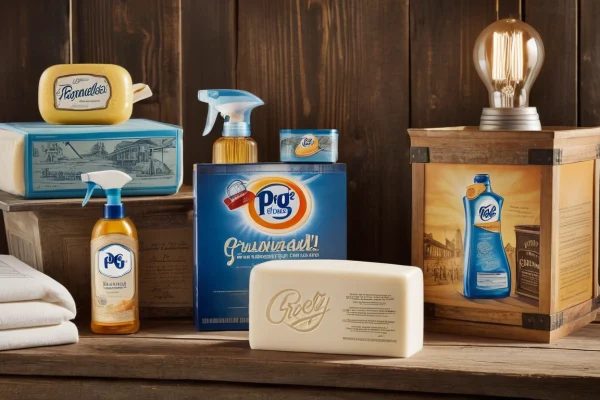Who Inspired the Development of Procter & Gamble?

- Who Inspired the Development of Procter & Gamble?
- Founders: William Procter and James Gamble
- Innovations That Shaped the Brand
- Product Development Milestones
- Market Research Techniques
- Branding and Advertising Strategies
- Influential Leadership Figures
- Global Expansion and Strategy
- International Market Penetration
- Cultural Adaptation of Products
- Frequently Asked Questions
When we think of Procter & Gamble, we often envision a vast array of household products that have become staples in our lives. But have you ever wondered who inspired the journey of this remarkable company? The story of P&G is not just about its products; it’s a tale of vision, innovation, and the relentless pursuit of excellence. At its heart are two men: William Procter and James Gamble, whose partnership laid the groundwork for what would become a global consumer goods giant.
Founded in 1837, Procter & Gamble was born from the union of Procter’s candle-making skills and Gamble’s expertise in soap making. This partnership was more than just a business arrangement; it was a fusion of creativity and practicality. The duo recognized the importance of quality and consistency, which became the foundation of their business philosophy. Their commitment to producing superior products not only set them apart from competitors but also established a legacy that continues to influence the company today.
However, the inspiration for P&G’s development extends beyond its founders. Throughout its history, various figures and innovations have played pivotal roles in shaping the brand. For instance, the introduction of groundbreaking marketing strategies and product innovations revolutionized the consumer goods industry. Here are some key elements that contributed to P&G’s success:
- Innovative Product Development: The launch of iconic brands like Tide in 1946 and Pampers in 1961 transformed consumer expectations and set new industry standards.
- Market Research Techniques: P&G was one of the first companies to employ rigorous market research, allowing it to tailor products to meet consumer needs effectively.
- Branding and Advertising Strategies: Creative advertising campaigns, such as the famous “Thank You Mom” campaign during the Olympics, helped P&G resonate with consumers on an emotional level.
In conclusion, the journey of Procter & Gamble is a testament to the power of collaboration and innovation. The inspiration drawn from its founders, along with the contributions of numerous influential leaders and groundbreaking strategies, has allowed P&G to thrive in a competitive market. As we look back at the origins of this iconic brand, it’s clear that the spirit of Procter & Gamble is not just about products—it’s about a legacy of inspiration that continues to evolve and inspire future generations.
Founders: William Procter and James Gamble
When you think about Procter & Gamble, it’s hard not to marvel at the incredible journey it has taken from a modest soap company to a global powerhouse in consumer goods. This remarkable transformation can be traced back to its founders, William Procter and James Gamble, whose vision and collaboration laid the groundwork for a legacy that continues to thrive today.
William Procter, a candle maker, and James Gamble, a soap maker, joined forces in 1837, driven by the idea that they could create something greater together than as individuals. Their partnership was not just a business decision, but a strategic alliance that combined their unique skills and knowledge. This collaboration was crucial, as it allowed them to pool their resources and innovate in ways they couldn’t have achieved alone.
Let’s take a closer look at their backgrounds:
| Name | Background | Contribution |
|---|---|---|
| William Procter | Candle Maker | Established the foundations of product quality and manufacturing processes. |
| James Gamble | Soap Maker | Innovated product formulations and marketing strategies. |
Procter & Gamble’s success can also be attributed to their ability to adapt to changing market demands. They understood the importance of consumer needs and preferences, which was revolutionary at the time. Their approach was simple yet effective: listen to the customer. This philosophy not only helped them create products that resonated with consumers but also established a strong brand loyalty that is still evident today.
Moreover, the duo’s commitment to quality and innovation paved the way for groundbreaking products that have become household names. From the iconic Tide laundry detergent to Pampers, their legacy of excellence continues to inspire future generations of entrepreneurs.
In conclusion, the partnership of William Procter and James Gamble was not just about creating a company; it was about inspiring a culture of innovation and adaptation. Their story serves as a powerful reminder that collaboration and a keen understanding of consumer needs are essential ingredients for success in any industry.
Innovations That Shaped the Brand
When we think about Procter & Gamble, it’s hard not to marvel at the sheer scale of its impact on the consumer goods industry. But what truly set this company apart? The answer lies in its relentless pursuit of innovation. From its inception, P&G has been a pioneer, introducing groundbreaking products and marketing strategies that have revolutionized how we think about household goods.
One of the most significant innovations was the introduction of the concept of brand management in the 1930s. This approach allowed P&G to create a more personalized connection with consumers. Instead of just selling products, they began to build brands that resonated with people’s lives. For instance, the launch of Tide in 1946 not only transformed laundry day for millions but also set a new standard for product quality and branding.
| Year | Innovation | Impact |
|---|---|---|
| 1946 | Tide Launch | Revolutionized laundry detergents, leading to market dominance. |
| 1961 | Pampers Introduction | Transformed baby care with disposable diapers. |
| 1985 | Swiffer Launch | Innovated cleaning with convenient, easy-to-use products. |
Moreover, P&G has always been at the forefront of market research. By employing sophisticated techniques to understand consumer preferences, they have been able to tailor their products effectively. This is evident in their marketing campaigns that often reflect the values and lifestyles of their target audience. For example, the “Thank You, Mom” campaign during the Olympics not only highlighted their products but also connected emotionally with consumers, reinforcing brand loyalty.
In addition to product development, P&G has also embraced cutting-edge technologies in manufacturing and logistics. This has allowed them to maintain high standards of quality while keeping costs down. The combination of innovative products, smart marketing, and efficient operations has propelled P&G to the forefront of the industry, making it a household name worldwide.
In conclusion, the innovations that shaped Procter & Gamble are not just about products; they encompass a broader vision of connecting with consumers and adapting to their needs. As we continue to see advancements in technology and changing consumer behaviors, one can only wonder: what will the next wave of innovation look like for this iconic brand?
Product Development Milestones
Procter & Gamble’s journey through the consumer goods landscape has been marked by significant that not only defined the brand but also revolutionized the industry. From humble beginnings, the company has consistently pushed the boundaries of innovation, resulting in household names that consumers trust. One of the earliest milestones was the introduction of Ivory Soap in 1882, which was notable for its purity and floatability. This product not only set the stage for P&G’s reputation for quality but also highlighted the company’s dedication to meeting consumer needs.
As the company evolved, so did its approach to product development. The launch of Tide in 1946 marked a turning point in the laundry detergent market. Tide was the first heavy-duty synthetic detergent, and it quickly became a household staple. Its success can be attributed to rigorous testing and a deep understanding of consumer preferences. This was a clear example of how Procter & Gamble utilized market research techniques to create products that resonated with their audience.
Another significant milestone was the introduction of Pampers in 1961, which transformed the diaper industry. Prior to Pampers, parents had limited options that were often messy and inconvenient. Pampers offered a disposable solution that was not only practical but also comfortable for babies. This innovation showcased P&G’s ability to identify gaps in the market and develop products that catered to evolving lifestyles.
| Product | Year Launched | Impact |
|---|---|---|
| Ivory Soap | 1882 | Set the standard for purity in soap. |
| Tide | 1946 | Revolutionized laundry with synthetic detergents. |
| Pampers | 1961 | Transformed diapering with disposable convenience. |
In addition to these groundbreaking products, Procter & Gamble has continuously adapted its offerings to meet the needs of diverse consumer segments. This adaptability has not only solidified its position as a market leader but has also inspired other companies to prioritize consumer-centric innovation. As we look at these , it’s evident that P&G’s commitment to quality, research, and consumer satisfaction has been the driving force behind its legendary success.
Market Research Techniques
Market research is the backbone of Procter & Gamble’s (P&G) success, allowing the company to stay ahead of the curve in the ever-evolving consumer goods landscape. By employing a variety of , P&G has been able to identify consumer needs, preferences, and trends effectively. This proactive approach has not only shaped their product development but has also solidified their position as a market leader.
One of the key techniques P&G utilizes is qualitative research. This involves in-depth interviews and focus groups, where consumers share their thoughts and feelings about products. By tapping into the emotions and motivations behind purchasing decisions, P&G gains valuable insights that quantitative data alone cannot provide. For instance, during the development of Tide Pods, consumer feedback highlighted the need for convenience and ease of use, which directly influenced the product’s design.
Additionally, P&G employs quantitative research methods, such as surveys and analytics, to gather numerical data on consumer behavior. This data is crucial in identifying market trends and measuring the effectiveness of marketing campaigns. The combination of qualitative and quantitative research allows P&G to have a well-rounded understanding of their consumers.
| Research Technique | Description | Benefits |
|---|---|---|
| Qualitative Research | In-depth interviews and focus groups to gather consumer insights. | Provides deep emotional insights and motivations. |
| Quantitative Research | Surveys and analytics to gather numerical data. | Identifies trends and measures campaign effectiveness. |
Moreover, P&G is renowned for its test markets. By launching products in select regions, they can monitor consumer reactions before a full-scale launch. This strategy minimizes risk and allows for adjustments based on real-world feedback. For example, the introduction of Swiffer was first tested in a limited market, leading to modifications that made the product more appealing to a broader audience.
In conclusion, the employed by Procter & Gamble are pivotal in their journey from a small soap company to a global giant. By understanding the consumer psyche and adapting to changing preferences, P&G not only innovates but also ensures that their products resonate with consumers worldwide. As they say, “The customer is always right,” and P&G takes this mantra to heart.
Branding and Advertising Strategies
When we think about Procter & Gamble, we can’t help but marvel at how they have masterfully crafted their branding and advertising strategies over the years. It’s like watching a magician pull a rabbit out of a hat, except this rabbit is a global empire of household names! From their early days, P&G understood that to stand out in a crowded market, they needed to do something extraordinary. So, what did they do?
First off, they embraced the power of storytelling. P&G’s advertisements often tell relatable stories that resonate with consumers on a personal level. For instance, their famous “Thank You, Mom” campaign during the Olympics not only showcased their products but also tugged at the heartstrings of viewers around the world. This emotional connection is what sets them apart from competitors and creates loyal customers.
Moreover, P&G has been a pioneer in the use of market research to inform their branding strategies. They don’t just guess what consumers want; they actively seek their opinions. This approach is akin to having a cheat sheet for a big exam—you know exactly what to study! By understanding consumer needs and preferences, they tailor their messaging to ensure it hits home.
Here’s a quick look at some pivotal branding strategies that have shaped P&G:
| Strategy | Description |
|---|---|
| Emotional Storytelling | Creating relatable narratives that connect with consumers. |
| Market Research | Utilizing consumer feedback to shape products and messaging. |
| Innovative Advertising | Leveraging new media and technology to reach audiences. |
Additionally, P&G has been at the forefront of innovative advertising techniques. They were among the first to embrace television as a powerful medium for reaching consumers, and they continue to adapt to digital platforms. By utilizing social media and influencer partnerships, they ensure that their brands stay relevant and engaging in today’s fast-paced environment.
In conclusion, the of Procter & Gamble are not just about selling products; they are about creating lasting relationships with consumers. By combining emotional storytelling, rigorous market research, and innovative advertising, P&G has established itself as a leader in the consumer goods industry. As they say, “It’s not just a product; it’s a lifestyle!”
Influential Leadership Figures
The journey of Procter & Gamble (P&G) from a modest soap manufacturer to a global powerhouse is a story steeped in the vision and dedication of its influential leadership figures. These individuals not only paved the way for innovation but also instilled a culture of excellence that resonates within the company to this day. Among them, names like David S. Taylor and John G. Smale stand out as transformative leaders who shaped the company’s trajectory.
David S. Taylor, who became CEO in 2015, is known for his emphasis on sustainability and innovation. Under his leadership, P&G has made significant strides in addressing environmental concerns. He famously stated, “We are committed to making a positive impact on the planet and the communities we serve.” This vision has not only helped P&G maintain its competitive edge but has also established it as a leader in corporate responsibility.
Another pivotal figure is John G. Smale, who served as CEO during the 1980s. His strategic foresight helped P&G navigate through economic challenges and expand its product lines. Smale’s approach to leadership was characterized by a strong focus on market research and consumer insights, which allowed P&G to tailor its offerings to meet the evolving needs of its customers. Under his guidance, the company introduced groundbreaking products that became household names.
| Leader | Tenure | Key Contributions |
|---|---|---|
| David S. Taylor | 2015 – Present | Emphasis on sustainability and innovation |
| John G. Smale | 1981 – 1990 | Expansion of product lines and focus on market research |
These leaders exemplify how effective leadership can inspire a company to not only adapt but thrive in a competitive landscape. Their legacies continue to influence P&G’s operations and its approach to leadership, innovation, and market engagement. By fostering a culture of collaboration and creativity, they have set a standard for future leaders within the organization.
In conclusion, the influential leadership figures at Procter & Gamble have played a crucial role in shaping the company’s identity and success. Their vision, commitment to innovation, and understanding of consumer needs have inspired countless employees and set a foundation for ongoing growth and adaptation in an ever-changing market.
Global Expansion and Strategy
Procter & Gamble (P&G) has mastered the art of global expansion, transforming from a humble soap manufacturer into a household name across the globe. But how did they achieve this remarkable feat? The answer lies in their strategic approach to understanding and adapting to different markets while staying true to their core values. Just like a chameleon adapts to its environment, P&G has tailored its strategies to fit the diverse cultural landscapes of the countries they enter.
One of the key elements of P&G’s global strategy is their emphasis on market research. By investing in comprehensive studies, they gain invaluable insights into consumer behaviors, preferences, and needs. This data-driven approach allows them to create products that resonate with local tastes. For instance, P&G recognized that laundry habits vary significantly around the world, leading to the development of products like Tide Pods, which cater to the convenience sought by busy households.
| Market | Product Adaptation | Consumer Preference |
|---|---|---|
| India | Smaller packaging for affordability | Value for money |
| Japan | Low-sudsing detergents | Preference for less foam |
| Brazil | Eco-friendly products | Growing environmental awareness |
Additionally, P&G’s branding and advertising strategies have played a crucial role in their global success. They utilize local celebrities and culturally relevant messaging to create connections with consumers. Think of it as a local band playing at a neighborhood block party; it feels more personal and engaging than a distant rock star. This tactic not only builds brand loyalty but also fosters a sense of community around their products.
In summary, P&G’s global expansion and strategy are a testament to their ability to evolve with the times. By focusing on cultural adaptation and leveraging deep market insights, they continue to thrive in an ever-changing global landscape. As they move forward, one can only wonder: what innovative strategies will they unveil next?
International Market Penetration
When it comes to , Procter & Gamble (P&G) is a masterclass in strategic expansion. The company didn’t just waltz into new markets; they approached each one with a well-crafted plan, ensuring that they understood the local culture, consumer behavior, and market dynamics. Imagine trying to sell ice to Eskimos without understanding their needs—P&G avoided this pitfall by prioritizing local insights.
One of the pivotal strategies that P&G employed was establishing a local presence. Rather than relying solely on exports, they invested in manufacturing facilities and local offices. This not only created jobs but also allowed them to adapt their products to meet the specific preferences of consumers in each region. For instance, in countries where laundry practices differ significantly, P&G tailored their detergent formulations accordingly.
| Market | Adaptation Strategy | Result |
|---|---|---|
| India | Affordable product sizes | Increased market share among low-income households |
| Japan | Focus on premium products | Established a strong brand presence in the luxury segment |
| Brazil | Localized marketing campaigns | Enhanced brand loyalty and consumer engagement |
Furthermore, P&G’s relentless focus on market research played a crucial role in their international success. They utilized sophisticated techniques to gather data on consumer preferences, enabling them to launch products that resonated with local audiences. This approach is akin to a chef who meticulously studies the local cuisine before crafting a menu, ensuring that every dish appeals to the diners’ tastes.
In summary, Procter & Gamble’s journey into international markets exemplifies how understanding local cultures and consumer needs can lead to successful market penetration. Their commitment to adapting products and marketing strategies has not only allowed them to thrive globally but also to build a lasting relationship with consumers around the world. As they continue to expand, their story serves as an inspiration for businesses aiming to make their mark on the global stage.
Cultural Adaptation of Products
Procter & Gamble (P&G) is a shining example of how cultural adaptation can lead to remarkable success in the global market. The company doesn’t just sell products; it tailors them to meet the unique needs of diverse cultures. This approach is akin to a chef adjusting a recipe to suit local tastes, ensuring that every consumer feels a connection to the brand.
One of the most significant ways P&G adapts its products is through extensive market research. By understanding local customs, preferences, and even language nuances, P&G creates products that resonate with consumers. For instance, when launching its famous Tide detergent in Asia, the company recognized that washing practices differ vastly from those in Western markets. Instead of merely importing the existing formula, P&G developed a variant specifically designed for cold water washes, which are more common in many Asian households.
To illustrate the impact of cultural adaptation, consider the following table that highlights some of P&G’s tailored products across different regions:
| Product | Region | Adaptation |
|---|---|---|
| Tide | Asia | Cold water formula |
| Pampers | Japan | Ultra-thin design |
| Head & Shoulders | Latin America | Fragrance customization |
Moreover, P&G employs a strategy of incorporating local languages and cultural references into its advertising campaigns. This method not only enhances relatability but also builds trust with the consumer base. For example, in India, P&G launched a campaign featuring local celebrities who resonate with the target audience, thereby creating a stronger emotional bond.
In conclusion, the cultural adaptation of products is not just a marketing strategy for Procter & Gamble; it is a philosophy that drives the company’s global success. By respecting and embracing cultural differences, P&G not only meets consumer needs but also fosters brand loyalty across the globe. Isn’t it fascinating how a little cultural understanding can lead to such big results?
Frequently Asked Questions
- Who were the founders of Procter & Gamble?
The company was founded by William Procter and James Gamble in 1837. They were both immigrants who came together to create a small soap and candle business that has since transformed into a global consumer goods powerhouse.
- What innovations have shaped Procter & Gamble?
Procter & Gamble has introduced numerous groundbreaking innovations, including the launch of products like Tide and Pampers. Their innovative marketing strategies, such as targeted advertising and market research techniques, have also played a significant role in their success.
- How has Procter & Gamble expanded globally?
The company has strategically penetrated international markets by adapting to local cultures and consumer preferences. This approach has allowed them to maintain their core values while ensuring their products resonate with diverse audiences worldwide.
- What role did market research play in Procter & Gamble’s success?
Market research has been crucial for Procter & Gamble, enabling them to understand consumer needs and preferences. This insight has driven product development and marketing strategies, ensuring their offerings align with what customers truly want.
- Who are some influential leaders at Procter & Gamble?
Throughout its history, Procter & Gamble has been guided by visionary leaders who made strategic decisions that propelled the company forward. Their leadership has been integral to navigating challenges and seizing opportunities in the competitive market.





